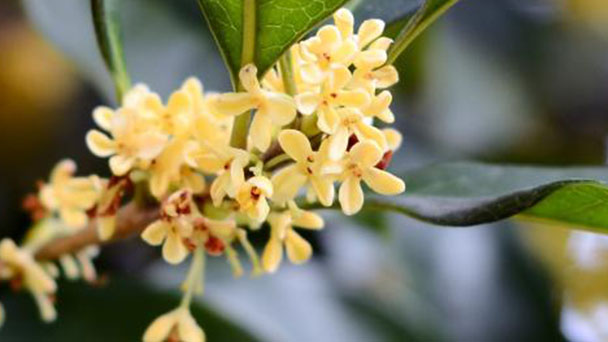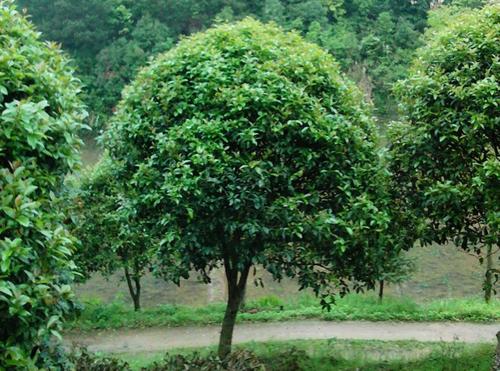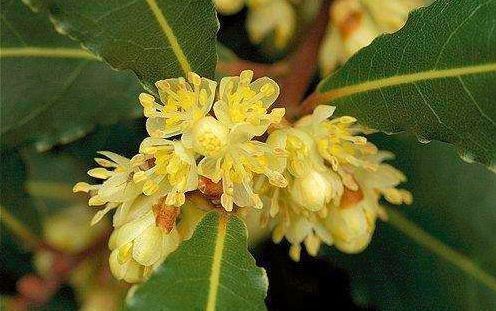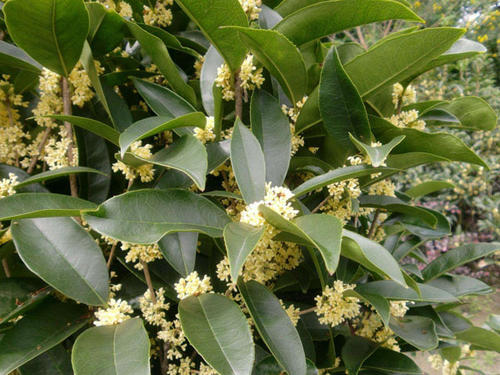Bay laurel (Laurus nobilis) profile
Written by Maggie
Oct 09 2021

Bay laurel (Laurus nobilis) is a subtropical tree of the genus Bay laurel of Lauraceae. Bay laurel is a small evergreen tree or shrub with oval crown, lower branches, green branches and aroma. Sweet Bay is light loving and slightly shade tolerant. Bay laurel likes warm and humid climate, but also short - term low temperature (-8℃). Origin areas of China, Zhejiang, Jiangsu, Fujian, Taiwan, Sichuan and Yunnan provinces have been introduced and cultivated.
Bay laurel picture
Bay laurel info
| Botanical Name | Laurus nobilis |
| Common Names | Bay laurel, laurel, bay tree, |
| Plant Type | Broadleaf evergreen shrub or small tree |
| Sun | Full sun to part shade |
| Hardiness Zones | 8–10 (USDA) |
| Flower color | Pale yellow |
| Native Area | Mediterranean regions |
| Mature size | 10–60 feet tall, 5–20 feet wide; container plants are generally kept pruned to 4–6 feet |
Bay laurel morphological characteristics
Bay laurel is a small evergreen tree or shrubbery tree up to 12 m tall with dark brown bark. Branchlets are cylindrical, longitudinally pinstripes, young parts slightly puberulent or sub glabrous. Leaves are alternate, oblong or oblong-elliptic, lanceolate, 5.5-12 cm long, 1.8 3.2 cm wide, apex sharp or acuminate, base cuneate, margin thin corrugated, leathery, dark green above, the following is a bit light, two sides glabrous, pinnate veins, midrib and lateral veins raised on both sides, lateral veins 10-12 per side, near the edge at the end arc links, fine vein anastomosis, two sides much visible, comb shaped; Petiole is 0.7-1 cm long, purplish red when fresh, slightly pubescent or sub glabrous, ventrally fluted.
The flowers of Bay laurel are dioecious. Inflorescences are umbellate, axillary, 1-3 in clusters or short racemes, surrounded by 4 alternating involucral bracts, globose before flowering; Involucral bracts are suborbicular, glabrous outside, sericeous inside, pedicels up to 7 mm, slightly pubescent or sub glabrous. Male flowers: 5 per umbel; Flowers of Bay laurel are small, yellow-green, pedicels ca. 2 mm, pubescent, perianth tube short, densely pubescent outside, perianth lobes 4, broadly ovate or suborbicular, adnate on both sides; Fertile stamens are usually 12, arranged in three wheels, first filaments glandless, first, second, and third filaments with a pair of sessile reniform glands in the middle, anthers elliptic, 2-loculed, ventricular; Ovary is sterile. Female flowers: usually staminodes 4, alternate with perianth segments, filament apex with a pair of sessile glands extending between them a lanceolate liguulate; Ovarian 1-loculed, style short, stigma slightly enlarged, obtuse triangulate. Fruit is oval-shaped, dark purple when ripe.
Bay laurel growing environment
Bay laurel is light - loving, slightly shade tolerant. Bay laurel likes warm and humid climate, but also short - term low temperature (-8℃). Deep, fertile, well drained loam or sandy loam is preferred. Bay laurel is not tolerant of salt and alkali. Sweet bay is afraid of waterlogging.
Bay laurel distribution
Origin areas of China, Zhejiang, Jiangsu, Fujian, Taiwan, Sichuan and Yunnan provinces have been introduced and cultivated.
How to grow and care for bay laurel
Light
If you develop your bay laurel indoors, preserve it close to a sunny window for the winter. Avoid publicity to each draft and warmth from appliances. Outdoor flora pick section coloration however will tolerate full sun. In areas with hot, dry summers, some afternoon color is ideal.
If they develop the plant to supply leaves for cooking, they produce the nice taste if the plant is given full solar for at least a element of the year.
Soil
Bay laurel is now not too precise about soil type, however it needs to be well-draining. It will do equally nicely in acidic and alkaline soils. Container flowers can be grown in everyday industrial potting mix. Plant your bay tree at the equal depth as it was once planted in its unique pot.
Water
bay laurel roots are very shallow, and general watering may additionally be crucial for the duration of dry spells. Use warning when weeding or cultivating round the base of the tree. Water it often however usually enables the soil to dry out between waterings, so the roots don’t rot.1 Although your bay tree will likely simply go dormant and drop a few leaves, you do not now favor its soil to continue to be dry for prolonged periods.
Temperature and humidity
bay laurel is solely hardy in USDA hardiness zones eight thru 10. In cooler areas, carry it indoors for the iciness and supply it in particularly cool conditions. However, you may additionally have hassle retaining your indoor bay tree from drying out in the low humidity of your home. When its indicators bother by way of shedding a few leaves, use the leaves in cooking and start misting the tree often with water.
Fertilizer
Since bay laurel is slow-growing, it doesn’t require an amazing deal of food. Plants in containers want some supplemental fertilizer. Feed a container-grown bay plant in the spring and once more in mid-summer, the use of a balanced natural fertilizer, such as fish emulsion and kelp. It additionally helps to refresh the pinnacle couple of inches of soil every spring, being cautious now not to harm the shallow roots.
Repotting
Bay laurel makes a famous container plant that can stay for decades. To maintain its measurement in check, use a fantastically small container. Just make certain it has a large sufficient base to stop the tree from toppling over in the wind. A 24-inch pot ought to be satisfactory for a 4- to 6-foot tree. Grow the plant in everyday industrial potting mix.
Bay laurel looks to develop nice when it is a little cramped in its pot, even to the factor of roots beginning to poke out the bottom. You shouldn’t want to re-pot greater than as soon as each and every 5 years.
Is bay laurel toxic?
Bay laurel leaves include eugenol and different vital oils that make them a remarkable meals seasoning for humans, however which are poisonous to dogs, cats, and horses.1
Symptoms of poisoning
Vomiting and diarrhea can end in animals that devour the leaves of bay laurel. Large ingestion can once in a while reason intestinal blockage. Although no longer poisonous to humans, some humans discover the oil from the leaves to be a moderate pores and skin irritant.2
Varieties of bay laurel
It’s very necessary that you grow bay laurel if you sketch to use the leaves for cooking and eating. There are different flora that go via the frequent names of bay and candy bay, however these are no longer always edible. There are additionally a few decorative cultivars of laurus nobilis that may additionally no longer have pretty the identical style as the pure species plant.
Laurus nobilis 'Angustifolia': Also acknowledged as willow-leaf laurel, the slender leaves of this cultivar are prized for their appealing texture when the tree is pruned.
Laurus nobilis 'Aurea': This range well-knownshows new leaves that are shiny yellow and aromatic.
Laurus nobilis 'Undulata': With this cultivar, the leaf edges are rippled or wavy, making it a specifically decorative tree.
Laurus nobilis 'Saratoga': This is a smaller tree when planted in the landscape, developing to a most of 30 feet. The leaves are greater rounded and lighter in color. It makes a right range for meals seasoning leaves.
Pruning Bay Laurel
If left unpruned, bay bushes can develop 60 toes tall. Container-grown timber and timber that are usually pruned will no longer get somewhere close to that tall. To maintain your potted bay tree portable, hold it pruned to a manageable measurement and desireable shape. Pruning is typically executed in the spring, as new increase is simply beginning. You can prune as tons or as little as you like to preserve the tree small or to create a topiary artwork.
There is little method concerned in pruning a bay laurel, as the plant will sprout new dense boom from anyplace you snip off the branches. The method is absolutely simply about controlling the measurement and growing the form you want.
If your bay is hit by means of a mild frost, the leaves will likely flip brown and dry. Often the tree will get better on its personal the following spring. If your tree does exhibit symptoms of die-back in the spring, prune the stem down to beneath the harm and new boom have to fill in. In severe cases, reduce the whole plant down to about 6 inches and enable new shoots to structure from the base.

Harvesting bay laurel leaves
Mature leaves can be picked at any time for use in recipes. Plants must be at least two years historical earlier than the leaves are harvested. Cure the leaves by laying them on parchment paper and permitting them to dry for two weeks in a warm, dry place.
Leaves of the bay laurel have many culinary uses. Bay is additionally a standard aspect of the French bouquet garni herbs. The darkish inexperienced leaves are very fragrant, in particular when dried. As a seasoning, dried leaves are damaged or crumbled into cooking meals and allowed to permeate the dish. The leaves don’t soften a whole lot in cooking and are eliminated earlier than eating. The leaves are additionally used to make aromatic wreaths and garlands.
Bay laurel has additionally been an ordinary medicinal plant, which makes use of as diverse as earaches, rheumatism, and insect repellent. But be suggested that some humans locate the leaf oils to be a pores and skin irritant.2
Bay laurel pests & diseases
For the most part, the bay laurel is pest-free. In fact, the plant and its leaves are regularly used to deter pests from different flowers and in the pantry.
Scale can once in a while turn out to be a hassle and moths every now and then lay their eggs between two leaves and fuse them collectively with a cottony fluff. If you see two leaves that show up to be caught together, gently peel them aside and put off the eggs or larva.
Bay laurel propagation
The propagation method of Bay laurel is mainly based on cuttage propagation, and can also be sown and divided.
Prevention of diseases and pests of bay laurel
The main Bay laurel pests are: red wax scale, large moth, can be used 80% dichlorvos 1000 times the spray control; Disease has yellowing disease, can spray
Bay laurel main value
Ornamental value
Bay laurel is evergreen throughout the year, with beautiful trees and strong fragrance. It is suitable for planting in front of courtyards and buildings, and its foliage is especially beautiful. The front yard of the house is used as a green wall to separate the space and conceal the space. The effect is good.
Medical value
Flower: disperse cold break knot, dissolve phlegm and relieve cough. For toothache, cough and asthma sputum, amenorrhea abdominal pain.Fruit: warm stomach, smooth liver, disperse cold.Used for deficiency cold stomach ache. Root: dispelling wind and dampness, dispersing cold.Used for rheumatic muscle and bone pain, lumbago, kidney deficiency and toothache.
The economic value
Leaves and fruits of Bay laurel contain aromatic oil, leaves contain 0.3-0.5% oil, but there are also as high as 1-3%, fruit contains about 1% oil, aromatic oil specific weight (15°C) 0.910-0.944, refractive index (20°C) 1.460-1.477, rotation of a 4°40 '-21 °40 main components are linalool, eugenol, geraniol and linolein, used for food and soap flavors; Leaves can be used as flavoring or as flavoring agent in cans; The seeds contain about 30% vegetable oil, which is used for industrial purposes.
Cooking value
Bay laurel leaves have a strong aroma that eliminates the meaty smell and is a great addition to French, Mediterranean and Indian flavors. As one of the basic spices in French cuisine, Sweet Bay leaves are added to soups, such as borscht and onion soups, to enhance their fragrance. In Indian cuisine, Bay laurel leaves are often found in biryani rice. The multi-layered flavor of Thai curries is not attributed to Bay laurel leaves, citronella and other spices.

Latest Updated
- Benefits of Bugleweed - 7 Science-backed Health Benefits
- Bugleweed Dangers & Side Effects - Is It Poisonous?
- How to Plant Evergreen Trees - What You Should Know
- When to Plant Evergreens - Grow Guide for Evergreen Trees
- 12 Wonderful Evergreen Shrubs for Your Garden
- 12 Popular Evergreen Plants with Pictures for Beginners
- When And How To Prune A Lilac Bush Like a Pro
- How to Grow & Care for Lilac Vine (Hardenbergia Violacea)
- Japanese Lilac Tree (Syringa Reticulata) Care & Propagation Guide
- Shumard Oak Pros and Cons - What to Know
Popular Articles
- Winter maintenance of Antirrhinum Majus
- How to Grow Terminalia Mantaly Tree
- How to Grow and Care for Crossostephium Chinense
- How to grow Antirrhinum Majus in spring
- Peristeria Elata (Dove Orchid) Profile: Info & Care Guide
- Underwatered Snake Plant (Sansevieria Trifasciata) - Signs And How To Fix
- How to Care for Brazilian Jasmine Plant (Mandevilla Sanderi)
- How to Grow & Care for Graptopetalum Purple Delight in Summer
- Rosa Chinensis (China Rose): Plant Growing & Care Tips
- How to Care for Baby Sun Rose (Aptenia Cordifolia)
